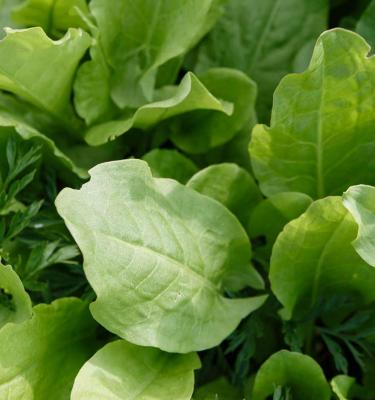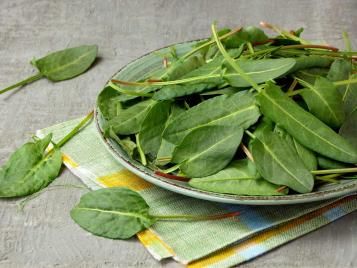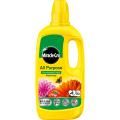

How to grow sorrel
Perennial herb sorrel is easy-to-grow and well suited to the UK climate. Sorrel, or Rumex spp., is a great substitute for spinach, with a similar texture but a sharper citrus flavour. Delicious in soups and salads, this bountiful plant will reward you with crops from late spring all the way through to the autumn.
Varieties of sorrel you can grow
Now you know what sorrel is, there are several varieties of sorrel to choose from which are all easy to grow:
- Common sorrel (Rumex acetosa). The most widely available, this large, clumping variety produces prolific amounts of leaves. Sometimes marketed as spinach dock and garden sorrel.
- French sorrel (Rumex scutatus). A small variety which reaches just 30cm (1’) tall, but can spread to up to 1m (3’) across. A less astringent flavour than others and a pronounced lemon taste.
- Red veined sorrel (Rumex sanguineus). Probably the most attractive variety of Sorrel, this one is as delicious as the others, but is also quite beautiful. The contrast of the green leaves and deep red leaf veins catches the eye in both the garden and in a large bowl of lettuce.
- Sheep’s or wild sorrel (Rumex acetosella). Often found growing in the wild, it’s also possible to cultivate it in the garden. Be wary of allowing it to self-seed however, as it will pop up all over the place and can become a bit of a nuisance. It has a very strong, sour flavour.

Essential equipment for growing sorrel
Growing sorrel is easy - you just need the following:
- A 9cm (3") diameter pot.
- Seed compost, such as Levington® Peat Free Seed Compost with added John Innes.
- Watering can with fine rose.
- Seeds.
- Compost (if growing in containers), such as Miracle-Gro® Peat Free Premium Moisture Control Compost for Pots & Baskets.
- Dibber.
Where to plant your sorrel
Sorrel typically reaches 60cm (24") high, with very strong roots that will compete with other plants. The flowers are not especially attractive, so this plant is one that can be planted behind or amongst other vigorous crops. It is usually grown as a perennial, so plant it where it can stay for a few years. It will tolerate sun or partial shade.
When to plant your sorrel
Sow sorrel seeds in pots from February through to April, before transplanting or directly outside from April to July. It’s great for planting in a gap in the veggie garden after early potatoes, broad beans or garlic have been lifted. As well as sowing from seed, sorrel plants can be purchased from horticultural retailers ready to plant out.
How to sow sorrel
- Fill the pot with compost, leaving 1cm (½") between the surface and the rim.
- Water the compost well, making sure any water drains away.
- Place 3-4 seeds on top of the compost, not allowing them to touch.
- Loosely cover seeds with 1cm (½") of compost, leaving a small gap between the surface and the lip of the pot.
- Move to a cool, light position.
- Keep seedlings watered. as they grow and don't allow them to dry out.
Once seeds sown indoors have grown to about 10cm and you have hardened them off and the weather is right, get ready to plant them out. The following Sorrel planting steps also apply to purchased Sorrel plants and for divided plants:
- Clear a patch of soil in the vegetable garden or border, or fill a container with a suitable compost.
- Use the dibber/trowel to create a hole in the soil or compost, large enough to plant the young Sorrel plant into. If planting more than one, allow 30cm (1’) between plants.
- Place the plant in the hole, with the bottom leaves of the seedling just above the top of the hole.
- Add more compost to the hole and around the stem of the plant . Firm the plant in so that there is good contact between the roots of the plant and the compost.
- Once planted, water and leave to grow on, keeping well watered especially in dry weather. Luscious green leaves will be ready to pick just a couple of months later.
Caring for sorrel
Keep sorrel well watered during hot summer months, and remove flowers as they appear. This will help to stop the plant from running to seed which makes the plant taste too bitter to eat. Keep picking the leaves too as this will encourage the plant to produce more young growth.
Frosts will kill off foliage later in the year, but the plant will remain alive beneath the surface, ready to re-shoot in the spring. Divide plants every 2-3 years in the spring or autumn to maintain good air circulation around plants.
Harvesting sorrel
Harvest leaves from the earliest sowings from May onwards. Later sowings will be ready in the summer. Young sorrel leaves are softer and tangier, whereas older, larger leaves are better for cooking and less flavourful. Use them fresh in salads alongside other lettuce-type leaves. Choose leaves which have an even shade of green, and that aren’t showing any signs of yellowing or crispy brown areas.
Many varieties of sorrel contain oxalic acid, which can be poisonous if eaten regularly and in quantity, so don’t eat them every day.
Storing sorrel
Sorrel is best eaten fresh, but if you want to preserve some for future use, then prepare it soon after harvesting. If possible, make it into your final dish before freezing it. For example, make a soup or stew before batching it up and freezing for use over the winter.
If it’s not possible to use sorrel leaves straight away, wash them and gently sandwich them between sheets of damp kitchen paper in a sealed container in the fridge.
Common Sorrel pests and diseases
Sorrel is fairly resilient to most pests and diseases, and will only really be affected by these very familiar creatures…
Slugs and snails
We have a great guide for combating these troublesome pests. Apply SlugClear™ Slug & Snail Barrier to newly planted sorrel as the young leaves are especially vulnerable.
Aphids
Aphids attack most plants, and sorrel is no exception. Tolerate small populations wherever possible, and encourage predators into the garden to help manage them. Use BugClear™ Ultra 2 if the problems continue.




